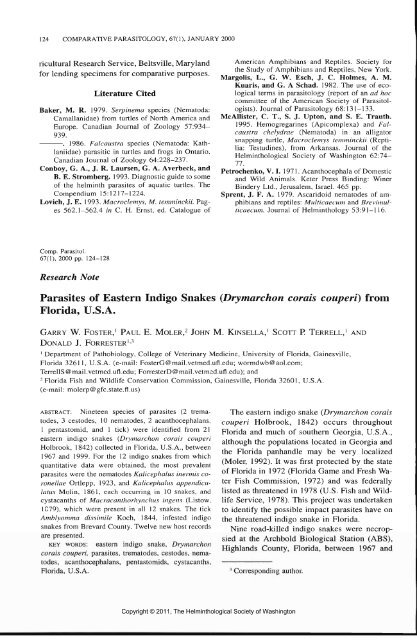Comparative Parasitology 67(1) 2000 - Peru State College
Comparative Parasitology 67(1) 2000 - Peru State College
Comparative Parasitology 67(1) 2000 - Peru State College
Create successful ePaper yourself
Turn your PDF publications into a flip-book with our unique Google optimized e-Paper software.
124 COMPARATIVE PARASITOLOGY, <strong>67</strong>(1), JANUARY <strong>2000</strong><br />
ricultural Research Service, Beltsville, Maryland<br />
for lending specimens for comparative purposes.<br />
Literature Cited<br />
Baker, M. R. 1979. Serpinema species (Nematoda:<br />
Camallanidae) from turtles of North America and<br />
Europe. Canadian Journal of Zoology 57:934-<br />
939.<br />
. 1986. Falcaustra species (Nematoda: Kathlaniidae)<br />
parasitic in turtles and frogs in Ontario.<br />
Canadian Journal of Zoology 64:228-237.<br />
Conboy, G. A., J. R. Laursen, G. A. Averbeck, and<br />
B. E. Stromberg. 1993. Diagnostic guide to some<br />
of the helminth parasites of aquatic turtles. The<br />
Compendium 15:1217-1224.<br />
Lovich, J. E. 1993. Macroclemys, M. te/nminckii. Pages<br />
562.1-562.4 in C. H. Ernst, ed. Catalogue of<br />
Comp. Parasitol.<br />
<strong>67</strong>(1), <strong>2000</strong> pp. 124-128<br />
Research Note<br />
American Amphibians and Reptiles. Society for<br />
the Study of Amphibians and Reptiles, New York.<br />
Margolis, L., G. W. Esch, J. C. Holmes, A. M.<br />
Kuaris, and G. A Schad. 1982. The use of ecological<br />
terms in parasitology (report of an ad hoc<br />
committee of the American Society of Parasitologists).<br />
Journal of <strong>Parasitology</strong> 68:131-133.<br />
McAllister, C. T., S. J. Upton, and S. E. Trauth.<br />
1995. Hemogregarines (Apicomplexa) and Falcaustra<br />
chelydrae (Nematoda) in an alligator<br />
snapping turtle, Macroclemys temminckii (Reptilia:<br />
Testudines), from Arkansas. Journal of the<br />
Helminthological Society of Washington 62:74-<br />
77.<br />
Petrochenko, V. I. 1971. Acanthocephala of Domestic<br />
and Wild Animals. Keter Press Binding: Winer<br />
Bindery Ltd., Jerusalem, Israel. 465 pp.<br />
Sprent, J. F. A. 1979. Ascaridoid nematodes of amphibians<br />
and reptiles: Multicaecum and Brevimulticaecum.<br />
Journal of Helminthology 53:91-116.<br />
Parasites of Eastern Indigo Snakes (Drymarchon corais couperi} from<br />
Florida, U.S.A.<br />
GARRY W. FOSTER,' PAUL E. MoLER,2 JOHN M. KINSELLA,' SCOTT P. TERRELL,' AND<br />
DONALD J. FORRESTER'-3<br />
1 Department of Pathobiology, <strong>College</strong> of Veterinary Medicine, University of Florida, Gainesville,<br />
Florida 32611, U.S.A. (e-mail: FosterG@mail.vetmed.ufl.edu; wormdwb@aol.com;<br />
TerrellS@mail.vetmed.ufl.edu; ForresterD@mail.vetmed.ufl.edu); and<br />
2 Florida Fish and Wildlife Conservation Commission, Gainesville, Florida 32601, U.S.A.<br />
(e-mail: molerp@gfc.state.fl.us)<br />
ABSTRACT: Nineteen species of parasites (2 trematodes,<br />
3 cestodes, 10 nematodes, 2 acanthocephalans.<br />
1 pentastomid, and 1 tick) were identified from 21<br />
eastern indigo snakes (Drymarchon corais couperi<br />
Holbrook, 1842) collected in Florida, U.S.A., between<br />
19<strong>67</strong> and 1999. For the 12 indigo snakes from which<br />
quantitative data were obtained, the most prevalent<br />
parasites were the nematodes Kalicephalus inermis corone<br />
llae Ortlepp, 1923, and Kalicephalus appendiculatus<br />
Molin, 1861, each occurring in 10 snakes, and<br />
cystacanths of Macracanthorhynchus ingens (Listow,<br />
1C79), which were present in all 12 snakes. The tick<br />
Arnblyomma dissimile Koch, 1844, infested indigo<br />
snakes from Brevard County. Twelve new host records;<br />
are presented.<br />
KEY WORDS: eastern indigo snake, Drymarchon<br />
corais couperi, parasites, trematodes, cestodes, nematodes,<br />
acanthocephalans, pentastomids, cystacanths,<br />
Florida, U.S.A.<br />
The eastern indigo snake (Drymarchon corais<br />
couperi Holbrook, 1842) occurs throughout<br />
Florida and much of southern Georgia, U.S.A.,<br />
although the populations located in Georgia and<br />
the Florida panhandle may be very localized<br />
(Moler, 1992). It was first protected by the state<br />
of Florida in 1972 (Florida Game and Fresh Water<br />
Fish Commission, 1972) and was federally<br />
listed as threatened in 1978 (U.S. Fish and Wildlife<br />
Service, 1978). This project was undertaken<br />
to identify the possible impact parasites have on<br />
the threatened indigo snake in Florida.<br />
Nine road-killed indigo snakes were necropsied<br />
at the Archbold Biological Station (ABS),<br />
Highlands County, Florida, between 19<strong>67</strong> and<br />
-1 Corresponding author.<br />
Copyright © 2011, The Helminthological Society of Washington
















